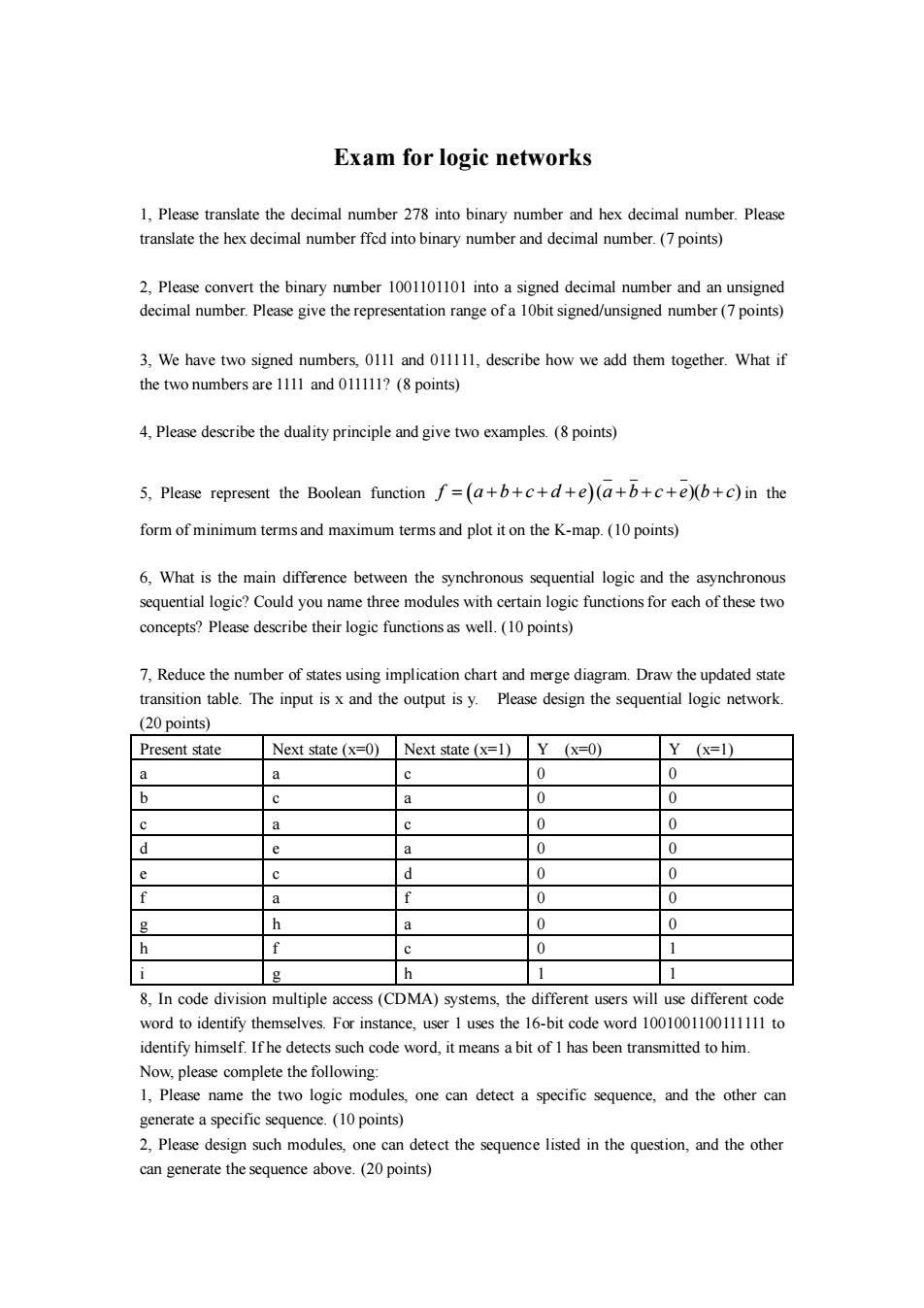正在加载图片...

Exam for logic networks 1,Please translate the decimal number 278 into binary number and hex decimal number.Please translate the hex decimal number ffcd into binary number and decimal number.(7 points) 2,Please convert the binary number 1001101101 into a signed decimal number and an unsigned decimal number.Please give the representation range of a 10bit signed/unsigned number(7 points) 3,We have two signed numbers,0111 and 011111,describe how we add them together.What if the two numbers are 1111 and 011111?(8 points) 4,Please describe the duality principle and give two examples.(8 points) 5,Please represent the Boolean function f=(a+b+c+d+e)(a+b+c+e)(b+c)in the form of minimum terms and maximum terms and plot it on the K-map.(10 points) 6,What is the main difference between the synchronous sequential logic and the asynchronous sequential logic?Could you name three modules with certain logic functions for each of these two concepts?Please describe their logic functions as well.(10 points) 7,Reduce the number of states using implication chart and merge diagram.Draw the updated state transition table.The input is x and the output is y.Please design the sequential logic network. (20 points) Present state Next state (x=0) Next state (x=1) Y (x=0) Y (x=1) a a 0 0 b c 0 0 c a c 0 0 d e a 0 0 e c d 0 0 f 8 f 0 0 g h a 0 0 h f 0 1 h 1 1 8,In code division multiple access(CDMA)systems,the different users will use different code word to identify themselves.For instance,user 1 uses the 16-bit code word 1001001100111111 to identify himself.If he detects such code word.it means a bit of 1 has been transmitted to him Now,please complete the following: 1,Please name the two logic modules,one can detect a specific sequence,and the other can generate a specific sequence.(10 points) 2,Please design such modules,one can detect the sequence listed in the question,and the other can generate the sequence above.(20 points)Exam for logic networks 1, Please translate the decimal number 278 into binary number and hex decimal number. Please translate the hex decimal number ffcd into binary number and decimal number. (7 points) 2, Please convert the binary number 1001101101 into a signed decimal number and an unsigned decimal number. Please give the representation range of a 10bit signed/unsigned number (7 points) 3, We have two signed numbers, 0111 and 011111, describe how we add them together. What if the two numbers are 1111 and 011111? (8 points) 4, Please describe the duality principle and give two examples. (8 points) 5, Please represent the Boolean function f a b c d e a b c e b c = + + + + + + + + ( )( )( ) in the form of minimum terms and maximum terms and plot it on the K-map. (10 points) 6, What is the main difference between the synchronous sequential logic and the asynchronous sequential logic? Could you name three modules with certain logic functions for each of these two concepts? Please describe their logic functions as well. (10 points) 7, Reduce the number of states using implication chart and merge diagram. Draw the updated state transition table. The input is x and the output is y. Please design the sequential logic network. (20 points) Present state Next state (x=0) Next state (x=1) Y (x=0) Y (x=1) a a c 0 0 b c a 0 0 c a c 0 0 d e a 0 0 e c d 0 0 f a f 0 0 g h a 0 0 h f c 0 1 i g h 1 1 8, In code division multiple access (CDMA) systems, the different users will use different code word to identify themselves. For instance, user 1 uses the 16-bit code word 1001001100111111 to identify himself. If he detects such code word, it means a bit of 1 has been transmitted to him. Now, please complete the following: 1, Please name the two logic modules, one can detect a specific sequence, and the other can generate a specific sequence. (10 points) 2, Please design such modules, one can detect the sequence listed in the question, and the other can generate the sequence above. (20 points)